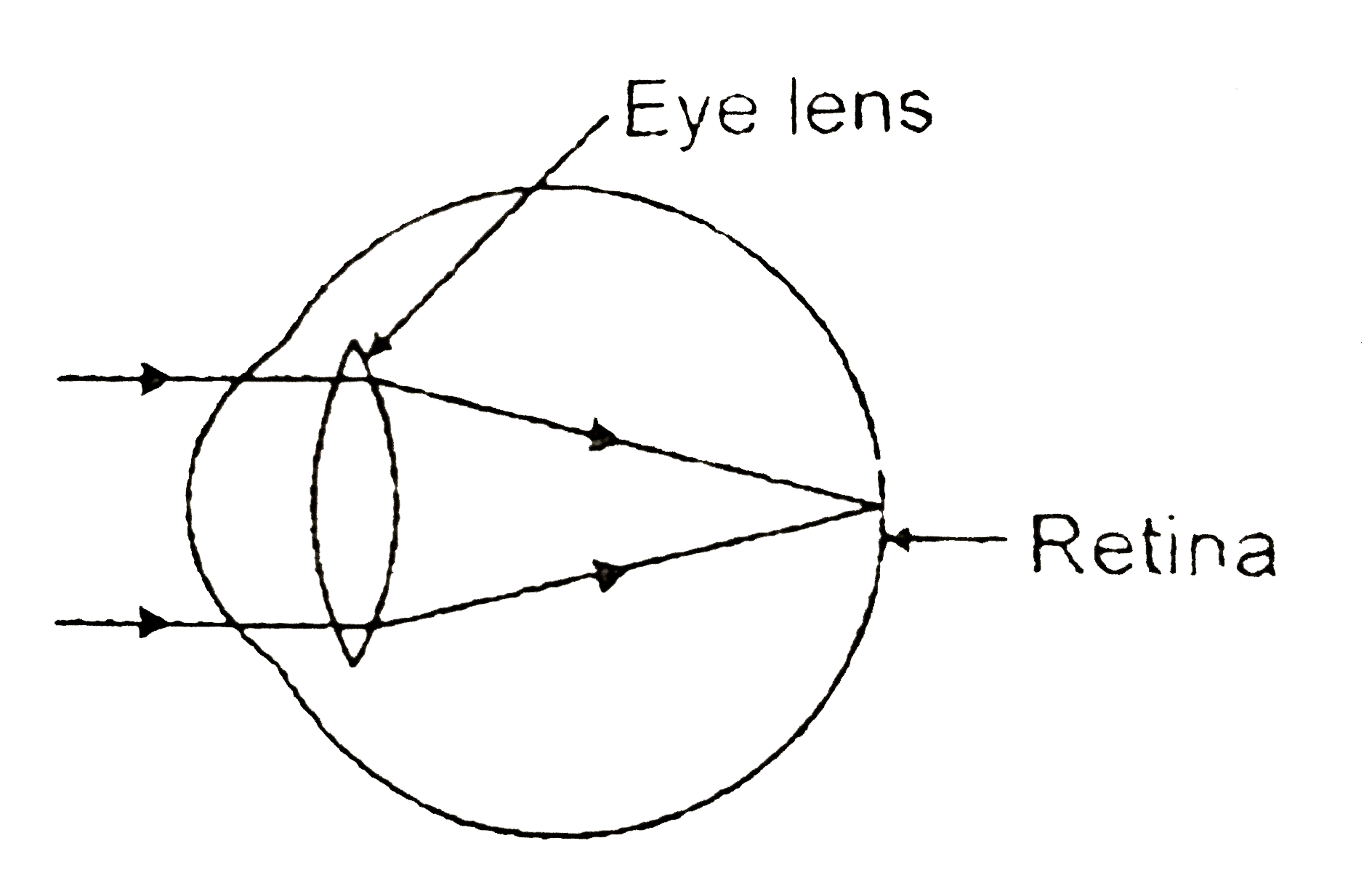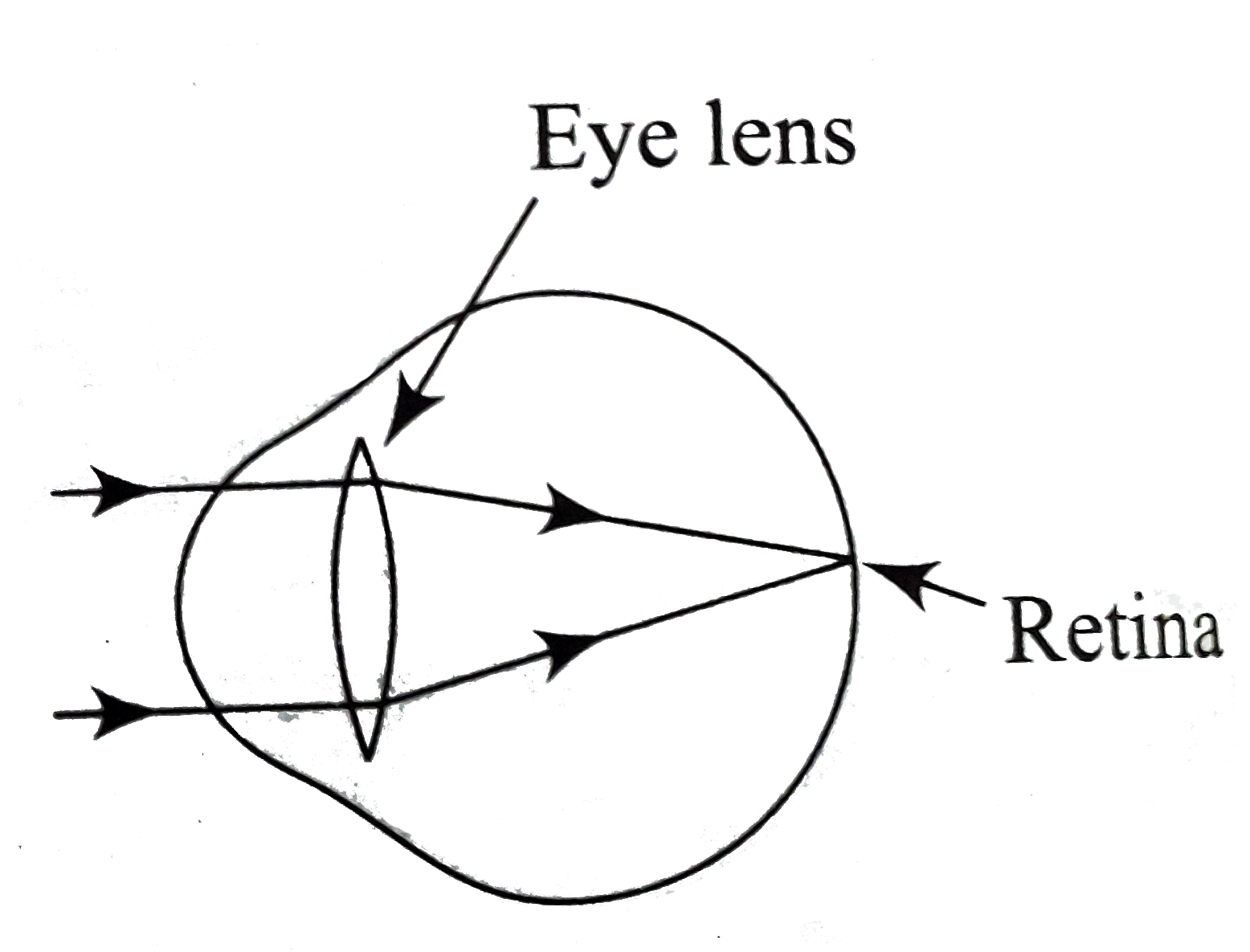A nearsighted man can clearly see objects up to a distance of 1.5m. Calculate the power of the lens of the spectacles necessary for the remedy of this defect.
−0.37D.
−67D.
−0.67D.
−37D.
The correct Answer is:C
To solve the problem of determining the power of the lens required for a nearsighted man who can clearly see objects only up to a distance of 1.5 meters, we can follow these steps:
Step 1: Understand the Condition of Myopia
A nearsighted (myopic) person can see nearby objects clearly but struggles with distant objects. In this case, the maximum distance at which the man can see clearly is 1.5 meters.
Step 2: Identify the Lens Type
To correct myopia, we need a diverging lens (concave lens) that will allow the person to see distant objects clearly. The lens will create a virtual image of distant objects (at infinity) at the distance where the person can see clearly (1.5 m).
Step 3: Use the Lens Formula
The lens formula is given by:
1f=1v−1u
where:
- f is the focal length of the lens,
- v is the image distance (which will be -1.5 m for a virtual image),
- u is the object distance (which is considered to be at infinity for distant objects, so u=∞).
Step 4: Substitute the Values into the Lens Formula
Since the object distance u is at infinity, we have:
1u=0
Thus, the lens formula simplifies to:
1f=1v−0
Substituting v=−1.5 m:
1f=1−1.5
This gives:
f=−1.5 m
Step 5: Calculate the Power of the Lens
The power P of a lens is given by the formula:
P=1f (in meters)
Substituting f=−1.5 m:
P=1−1.5=−23 diopters
Calculating this gives:
P=−0.67 diopters
Conclusion
The power of the lens required to correct the nearsightedness of the man is approximately -0.67 diopters.
---
A nearsighted (myopic) person can see nearby objects clearly but struggles with distant objects. In this case, the maximum distance at which the man can see clearly is 1.5 meters.
To correct myopia, we need a diverging lens (concave lens) that will allow the person to see distant objects clearly. The lens will create a virtual image of distant objects (at infinity) at the distance where the person can see clearly (1.5 m).
The lens formula is given by:
1f=1v−1u
where:
- f is the focal length of the lens,
- v is the image distance (which will be -1.5 m for a virtual image),
- u is the object distance (which is considered to be at infinity for distant objects, so u=∞).
Since the object distance u is at infinity, we have:
1u=0
Thus, the lens formula simplifies to:
1f=1v−0
Substituting v=−1.5 m:
1f=1−1.5
This gives:
f=−1.5 m
The power P of a lens is given by the formula:
P=1f (in meters)
Substituting f=−1.5 m:
P=1−1.5=−23 diopters
Calculating this gives:
P=−0.67 diopters
The power of the lens required to correct the nearsightedness of the man is approximately -0.67 diopters.
Topper's Solved these Questions
- OPTICAL INSTRUMENTSBOOK - HC VERMACHAPTER - OPTICAL INSTRUMENTSEXERCISE - Worked Out Examples
10 Videos
- OPTICAL INSTRUMENTSBOOK - HC VERMACHAPTER - OPTICAL INSTRUMENTSEXERCISE - Short Answer
11 Videos
- MAGNETIC PROPERTIES OF MATTERBOOK - HC VERMACHAPTER - MAGNETIC PROPERTIES OF MATTEREXERCISE - Exercises
9 Videos
- PERMANENT MAGNETSBOOK - HC VERMACHAPTER - PERMANENT MAGNETSEXERCISE - Exercises
25 Videos
Similar Questions
Knowledge Check
The ciliary muscles of eye control the curvature of the lens in the eye and hence can alter the effective focal length of the system. When the muscles are fully relaxed, the focla length is maximum. When the muscles are strained the curvature of lens increases (that means radius of curvature decreases) and focla length decreases. For a clear vision of curvature decreases) and focal length decreases. For a clear vision the image must be on retina. from eye-lens. it is about 2.5cmfor a grown-up person
A person can theoretically have clear vision of situated at any large distance from the eye. The smallest distance at which a person can clearly see is related to minimum possible focal length. The ciliary muscles are most straineed in this position. For an average grown-up person minimum distance of object sould be around 25cm.
A person suffering for eye defects uses spectacles (eys glass). The function of lens of spectacles is to form the image of the object within the range in which person can see clearly. The image of the spectacle-lens becomes object for eye-lens and whose image is formed on retina.
The number of spectacle-lens used for the remedy of eye defect is decided by the power of hte lens required and the number of spectacle-lens is equal to the numerical value of the power of lens with sign. for example power of lens required is +3D (converging lens of focal length 1003cm) then number of lens will be +3.

For all the calculations required you can use the lens formula and lens maker's formula. Assume that the eye lens is equiconvex lens. Neglect the distance between eye lens and the spectacle lens. A nearsighted man can clearly see object only upto a distance of 100cm and not beyond this. The number of the spectacles lens necssary for the remedy of this defect will be.A+1B−1C+3D−3The ciliary muscles of eye control the curvature of the lens in the eye and hence can alter the effective focal length of the system. When the muscles are fully relaxed, the focal length is maximum. When the muscles are strained, the curvature of lens increases. That means radius of curvature decreases and focal length decreases. For a clear vision, the image must be on the retina. The image distance is therefore fixed for clear vision and it equals the distance of retina from eye lens. It is about 2.5cm for a grown up person.
A perosn can theoretically have clear vision of an object situated at any large distance from the eye. The smallest distance at which a person can clearly see is related to minimum possible focal length. The ciliary muscles are most strained in this position. For an average grown up person, minimum distance of the object should be around 25cm.
A person suffering from eye defects uses spectacles (eye glass). The function of lens of spectacles is to form the image of the objects within the range in which the person can see clearly. The image o the spectacle lens becomes object for the eye lens and whose image is formed on the retina.
The number of spectacle lens used for th eremedy of eye defect is decided by the power fo the lens required and the number of spectacle lens is equal to the numerical value of the power of lens with sign. For example, if power of the lens required is +3D (converging lens of focal length 100/3cm ), then number of lens will be +3.
For all the calculations required, you can use the lens formula and lensmaker's formula. Assume that the eye lens is equiconvex lens. Neglect the distance between the eye lens and the spectacle lens.

Q. A near sighted man can clearly see ojects only upto a distance of 100cm and not beyond this. The number of the spectacle lenses necessary for the remedy of this defect will beA+1B1C+3D3A far-sighted man can see clearly at a distance of 1.0m. The power of the lens that would make him see clearly at a distance of 0.2m is
A4DB−4DC6DD−6D
If a person can see most clearly at a distance of 1000 cm .Find the power of the lens used to see object at 40 cm .
View SolutionA person suffering from the eye-defect myopia (short-sightedness) can see clearly only up to a distance of 2 meters. What is the nature and power of lens required to rectify this defect ?
View SolutionA person can not see clearly an object kept at a distance beyond of 100 cm. Find the nature and the power of lens to be used for seeing clearly the object at infinity.
View SolutionIf a person can sees clearly at a distance of 100 cm, then find the power of leris used to see object at 40 cm.
View SolutionA person can not see clearly object at a distance less than 100 cm . The power of the spectacles required to see clearly object at 25 cmis
View Solution
